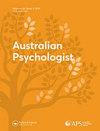自闭症谱系障碍中的述情障碍
IF 2
4区 心理学
Q2 PSYCHOLOGY, MULTIDISCIPLINARY
引用次数: 1
摘要
摘要目的述情障碍是一种以难以识别和描述自己的情绪和外部定向思维为特征的特征。鉴于研究强调自闭症谱系障碍(ASD)患者整体述情障碍水平升高,述情障碍对自闭症谱系障碍(ASD)患者具有临床意义。目前,关于述情障碍的哪些具体方面可能在ASD中受损,或者消极情绪和积极情绪是否都存在缺陷,我们知之甚少。因此,本研究旨在填补这一空白,建立ASD患者述情障碍的方面水平概况。方法采用珀斯述情问卷对55例ASD患者的述情水平进行评估,并与246例社区对照样本进行比较。结果我们发现,与社区对照样本(N = 246)相比,ASD (N = 55)患者述情障碍的所有方面(跨两个价域)都显著升高。评估述情障碍的所有方面,跨越两个价域,可能有助于识别具有特定社交和沟通困难的亚群,进而支持个性化干预措施的发展。关于该主题的已知内容:述情障碍是一个多维结构,由至少三个相互关联的组成部分组成:难以识别自己的感受(DIF),难以描述感受(DDF)和外部导向的思维方式(EOT)。珀斯述情障碍问卷(PAQ)是一种心理计量学上健全的述情障碍测量方法。述情障碍通常发生在自闭症谱系障碍(ASD)患者身上。本文补充的内容:在ASD组中,与社区组相比,述情障碍在所有方面(即DIF, DDF, EOT)都更高,支持ASD患者述情障碍水平升高。PAQ对于识别ASD患者之间的变异性和个体差异可能很重要,因为虽然三分之一的ASD参与者在“高述情障碍”范围内得分,但三分之二的人没有。识别述情障碍的独特特征可能对个性化治疗和干预具有关键意义。本文章由计算机程序翻译,如有差异,请以英文原文为准。
Alexithymia in autism spectrum disorder
ABSTRACT Objective Alexithymia is a trait characterised by difficulty identifying and describing one’s own emotions and externally orientated thinking. Alexithymia is of clinical interest in people with autism spectrum disorder (ASD) given research that has highlighted elevated levels of overall alexithymia in people with ASD. Presently, little is known about what specific facets of alexithymia might be impaired in ASD, or whether deficits are present for both negative and positive emotions. This study therefore aimed to fill this gap, establishing a facet-level profile of alexithymia in people with ASD. Method Using the Perth Alexithymia Questionnaire, levels of alexithymia were assessed in sample of 55 people with a diagnosis of ASD and compared with 246 people in a community control sample. Results We found that all facets of alexithymia (across both valence domains) were substantially elevated in ASD (N = 55) compared to a community control sample (N = 246). Conclusions Assessing all facets of alexithymia, across both valence domains, may help identify subgroups with particular social and communication difficulties, and in turn, support the development of personalised interventions. Key Points What is already known on this topic: Alexithymia is a multidimensional construct, comprised of at least three interrelated components: difficulty identifying one’s own feelings (DIF), difficulty describing feelings (DDF), and an externally orientated thinking style (EOT). The Perth Alexithymia Questionnaire (PAQ) is a psychometrically sound measure of alexithymia. Alexithymia commonly occurs in people with Autism Spectrum Disorder (ASD). What this paper adds: In the ASD group, alexithymia was higher across all facets (i.e., DIF, DDF, EOT) compared to the community group, supporting the elevated levels of alexithymia in people with ASD. The PAQ may be important for recognising variability and individual differences among people with ASD, as whilst one third of participants with ASD scored in the “high alexithymia” range, two thirds did not. Identifying unique profiles of alexithymia may have key implications for personalised treatment and interventions.
求助全文
通过发布文献求助,成功后即可免费获取论文全文。
去求助
来源期刊

Australian Psychologist
PSYCHOLOGY, MULTIDISCIPLINARY-
CiteScore
3.70
自引率
5.30%
发文量
32
期刊介绍:
The Australian Psychologist is the official applied practice and public policy journal of the Australian Psychological Society. As such, the journal solicits articles covering current issues in psychology, the science and practice of psychology, and psychology"s contribution to public policy, with particular emphasis on the Australian context. Periodically, Australian Psychological Society documents, including but not limited to, position papers, reports of the Society, ethics information, surveys of the membership, announcements, and selected award addresses may appear in the journal.
 求助内容:
求助内容: 应助结果提醒方式:
应助结果提醒方式:


